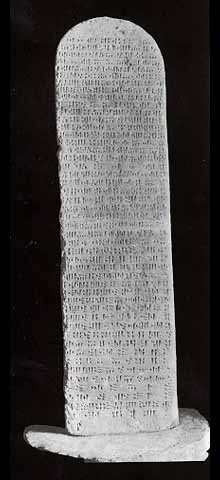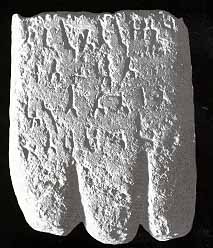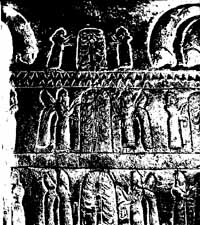|
 Like the Celtic cross, which was inherited from earlier pagan
stone monuments, the Armenian Khachkar can be traced to prehistoric
monuments. Its earliest roots may be menhirs which dot the Neolithic,
Copper and Bronze Age landscape. One menhir form is the obelisk,
which appeared beginning around 4000 BC. At MokhraBlur near Yerevan
the largest obelisk in Armenia can be found, a massive polished
black stone weighing in at 10 tons. Looking eerily like the great
obelisk floating in space at the beginning of "2001, Space Odyssey",
these early monuments are all the more mysterious for their massive
clean shape, and the fact they were hauled by hand from stone
quarries miles away. At MokhraBlur, the great obelisk is the only
stone element in that 4th millennium BC city of 25,000.
Like the Celtic cross, which was inherited from earlier pagan
stone monuments, the Armenian Khachkar can be traced to prehistoric
monuments. Its earliest roots may be menhirs which dot the Neolithic,
Copper and Bronze Age landscape. One menhir form is the obelisk,
which appeared beginning around 4000 BC. At MokhraBlur near Yerevan
the largest obelisk in Armenia can be found, a massive polished
black stone weighing in at 10 tons. Looking eerily like the great
obelisk floating in space at the beginning of "2001, Space Odyssey",
these early monuments are all the more mysterious for their massive
clean shape, and the fact they were hauled by hand from stone
quarries miles away. At MokhraBlur, the great obelisk is the only
stone element in that 4th millennium BC city of 25,000.
Another source is also a startling new discovery, which is causing international sensation as it is swept up in controversy over its proposed dating. The stone monuments at Karahundj (see "Armenia's Stonehenge?" in this same issue) were both part of an astronomical observatory and an outdoor sun worship temple. The overall shapes of the stones bear a striking likeness to the earliest Khachkars, though they don't contain engravings, and are rough cut except for their telescopic holes.
 The Vishaps
are perhaps the earliest direct link to Khachkars. Vishaps (Dragon
Stones) can be traced back to the 5th millennium BC, where large
fish-like monuments were placed at the sources of springs and
rivers and which became related to the worship of Astghik, the
goddess of water. Vishaps can still be found on the sides of
Mt. Aragats, Arayr and especially on the Geghama mountain range
that separates the Ararat valley from Lake Sevan. A few are
kept in museums, and several lie in the center of Yerevan. The Vishaps
are perhaps the earliest direct link to Khachkars. Vishaps (Dragon
Stones) can be traced back to the 5th millennium BC, where large
fish-like monuments were placed at the sources of springs and
rivers and which became related to the worship of Astghik, the
goddess of water. Vishaps can still be found on the sides of
Mt. Aragats, Arayr and especially on the Geghama mountain range
that separates the Ararat valley from Lake Sevan. A few are
kept in museums, and several lie in the center of Yerevan.
Those made of tuf have lost many of their features over thousands of years of exposure, but some retain their intricate, fearsome features, later adorned with astronomical and animal-human designs. The symbols used on Vishaps the fish, the cross and the sacred swastika were common to early Armenian religious iconography, symbols of life, redemption and universal power. The most powerful symbol was the sun, which is depicted on Vishaps as a swirling disc. The sun symbol is also the earliest sacred symbol in Armenia, dating back to the Paleolithic period (20,000-12,000 BC). Other sacred symbols found on menhirs, Vishaps and later obelisks are signs of the zodiac, dating back to the 3rd millennium BC.
 Boundary stones (some
of the oldest in Armenia are the boundary stones of the Babylonian
king Nemruth, also known as Bel in the legend of Haik) were
used to mark territories, and contained inscriptions of both
royal and religious meanings. The boundary stones used during
the reign of Artashes I (2nd c. BC) show examples of pre-Mashtots
Armenian script. By the Urartian period, obelisks which were
built from stone columns covered in cuneiform are considered
direct ancestors to the Khachkar. The obelisks incorporate a
universal Khachkar symbol, the tree of life. Boundary stones (some
of the oldest in Armenia are the boundary stones of the Babylonian
king Nemruth, also known as Bel in the legend of Haik) were
used to mark territories, and contained inscriptions of both
royal and religious meanings. The boundary stones used during
the reign of Artashes I (2nd c. BC) show examples of pre-Mashtots
Armenian script. By the Urartian period, obelisks which were
built from stone columns covered in cuneiform are considered
direct ancestors to the Khachkar. The obelisks incorporate a
universal Khachkar symbol, the tree of life.
 The tree of life is mentioned in Genesis in the Bible, but its
use in Ancestral Armenian iconography goes back to the Metsamorian
period, 5000 BC. It was universally used in the Near East as
a symbol of eternity and resurrection. In Urartu, the tree of
life was depicted with two side long sets of eight branches
crowned by three short branches at the peak. A god-like king
stood on one side of the tree, reaching for the eternal fruit.
The tree of life is mentioned in Genesis in the Bible, but its
use in Ancestral Armenian iconography goes back to the Metsamorian
period, 5000 BC. It was universally used in the Near East as
a symbol of eternity and resurrection. In Urartu, the tree of
life was depicted with two side long sets of eight branches
crowned by three short branches at the peak. A god-like king
stood on one side of the tree, reaching for the eternal fruit.
 The obelisk tradition continued in Armenia's Hellenistic and
Imperial Age, with contemporary historic sources remarking they
held a prominent place in Armenian cities, as well as along
the roads that linked them. These monuments continued to be
used in the early Christian period (4th-5th cc.) and were models
for column-like monuments bearing the sign of the cross. Examples
of this transitional form can be found at Talin and Artik. These
Christian obelisks were along with wooden crosses the earliest
forms of Khachkars.
The obelisk tradition continued in Armenia's Hellenistic and
Imperial Age, with contemporary historic sources remarking they
held a prominent place in Armenian cities, as well as along
the roads that linked them. These monuments continued to be
used in the early Christian period (4th-5th cc.) and were models
for column-like monuments bearing the sign of the cross. Examples
of this transitional form can be found at Talin and Artik. These
Christian obelisks were along with wooden crosses the earliest
forms of Khachkars.
|